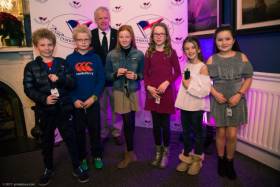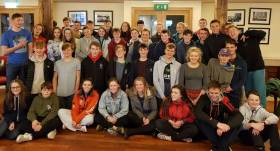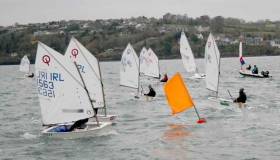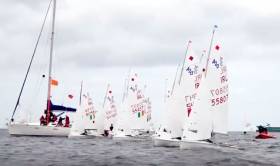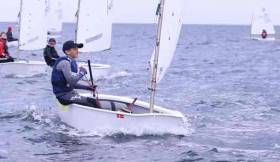Displaying items by tag: youth sailing
2017 National Yacht Club Junior Awards Presented
On Saturday November 25, the National Yacht Club hosted its annual junior awards dinner for 2017. Over 200 parents and children attended the event to celebrate junior sailing success on the water and to award the junior perpetual trophies.
Trophies were presented to the next generation of talented young sailors by club Commodore Ronan Beirne
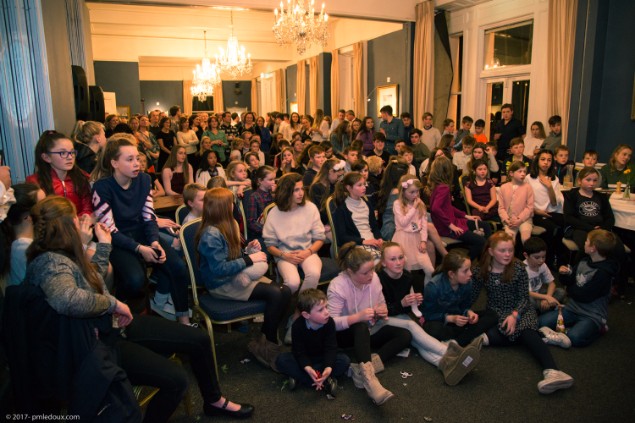 200 turned out for the awards ceremony at the NYC
200 turned out for the awards ceremony at the NYC
Among the highlights was the presentation to Loghlen Rickard of both the Lynch Trophy for being the highest ranked NYC Laser radial sailor and also the Cathy McAleavey Trophy for being the Junior that has made the most remarkable achievements in 2017.
Natasha Hemeryck was presented with the Topper trophy.
 Ella Hemeryck was awarded the trophy for being the 2nd highest ranked NYC laser radial sailor
Ella Hemeryck was awarded the trophy for being the 2nd highest ranked NYC laser radial sailor
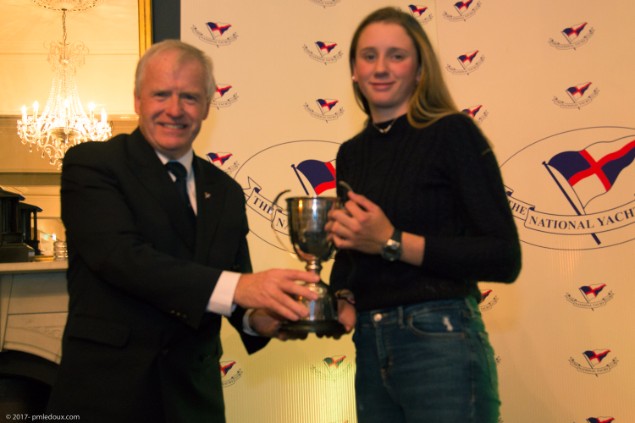 Clare Gorman was awarded the Laser 4.7 trophy
Clare Gorman was awarded the Laser 4.7 trophy
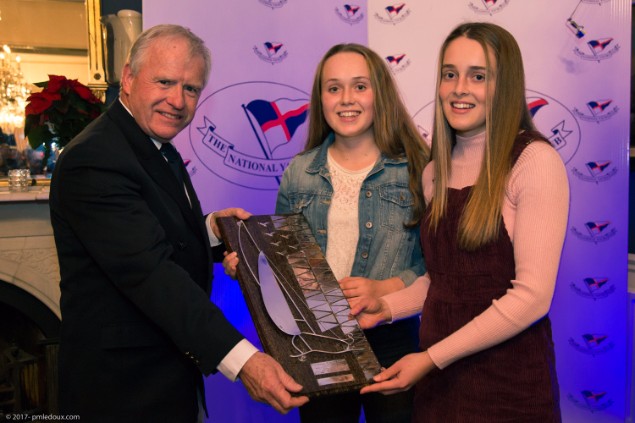 Nicola and Fiona Ferguson were presented with the double-handed Trophy for their 420 sailing
Nicola and Fiona Ferguson were presented with the double-handed Trophy for their 420 sailing
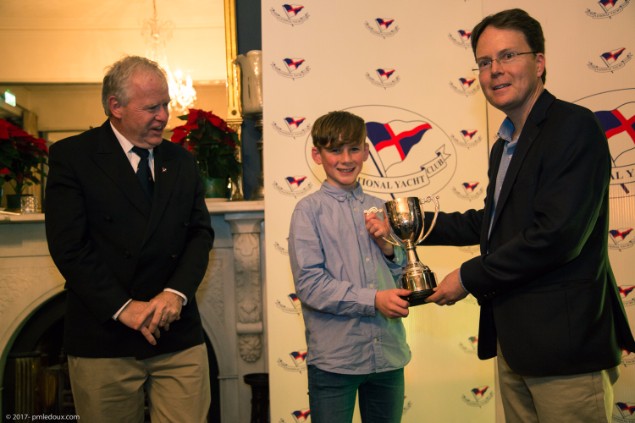 Conor Gorman was presented with the 1st Senior Optimist Trophy and Fiachra McDonnell was presented with the 1st Junior Optimist Trophy
Conor Gorman was presented with the 1st Senior Optimist Trophy and Fiachra McDonnell was presented with the 1st Junior Optimist Trophy
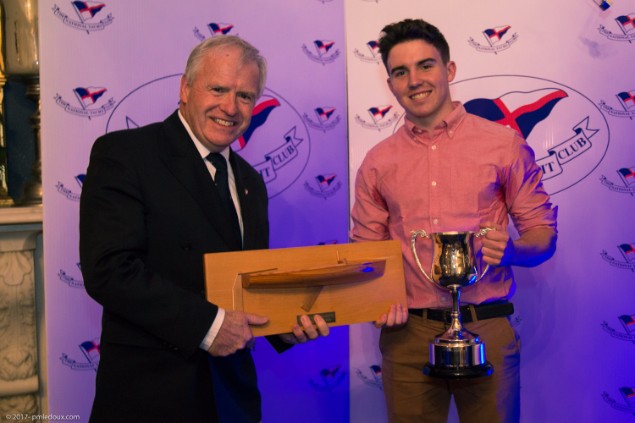
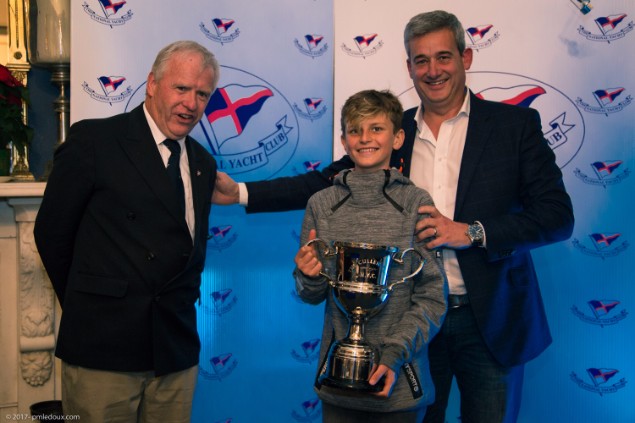

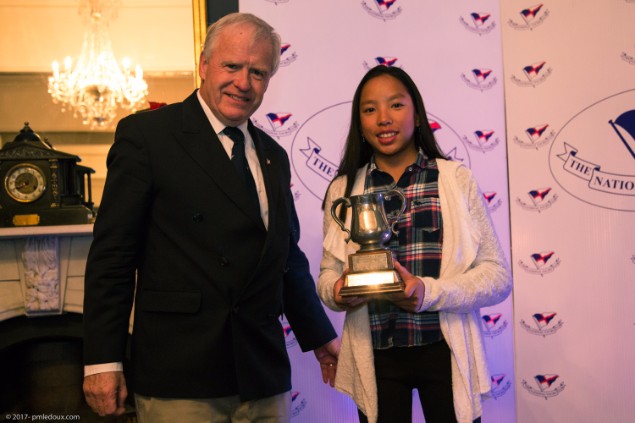
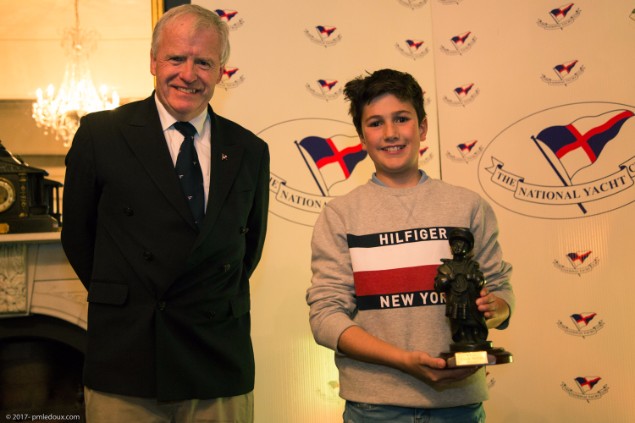
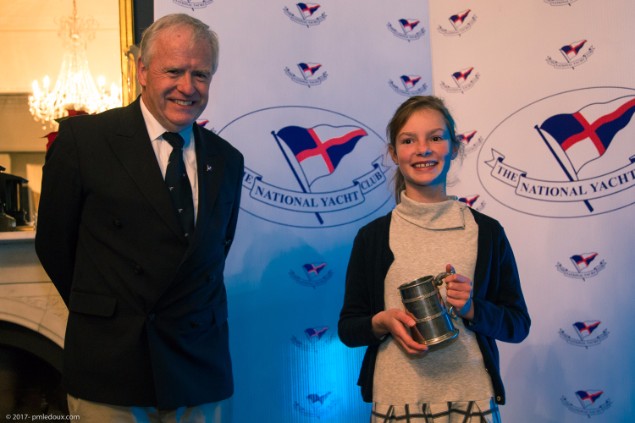
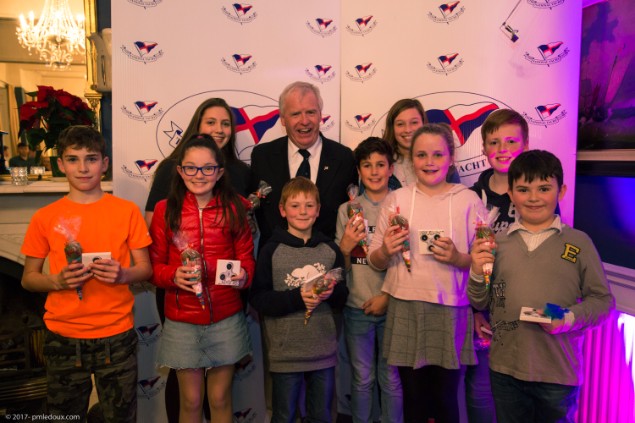
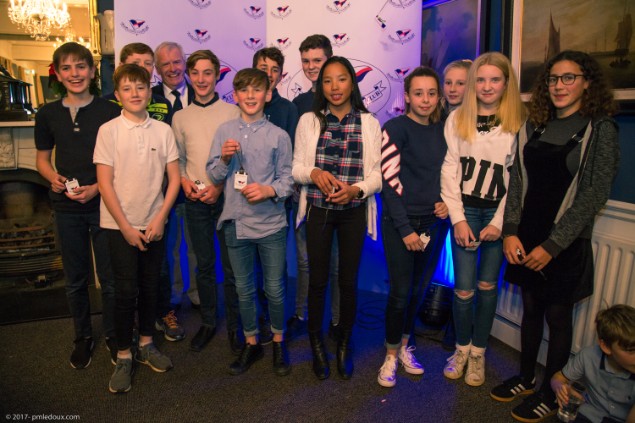

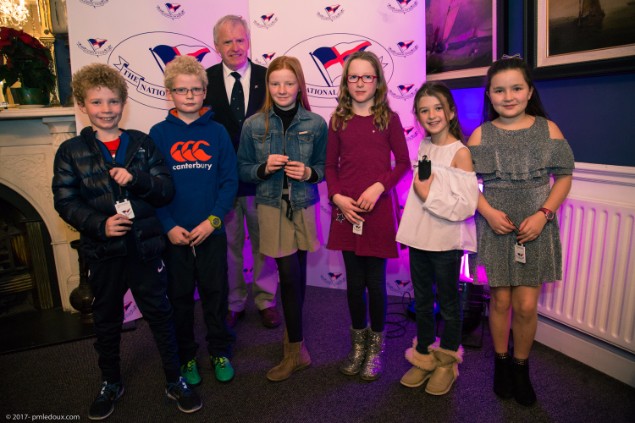
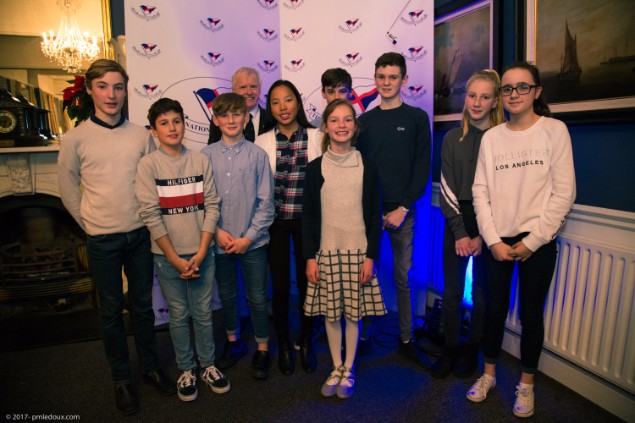
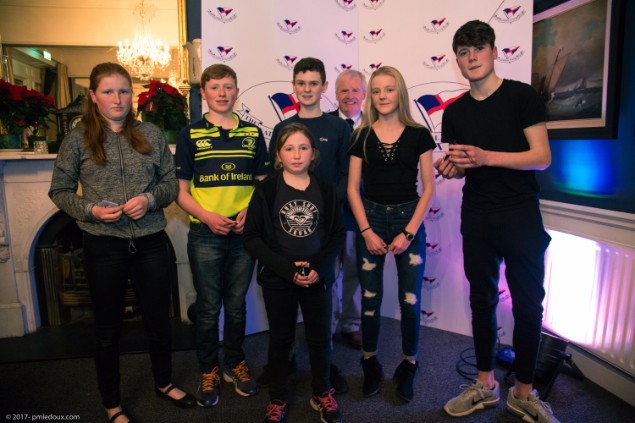
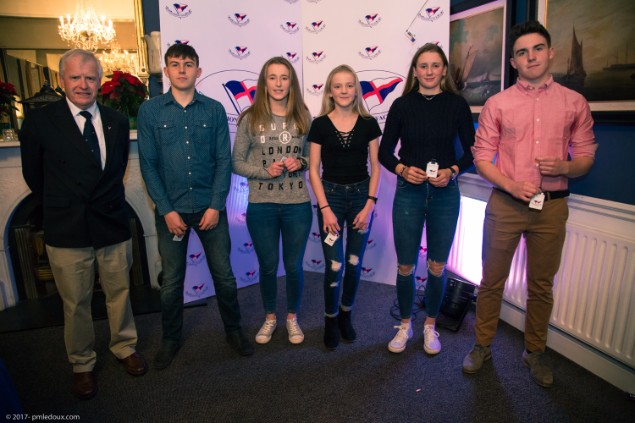
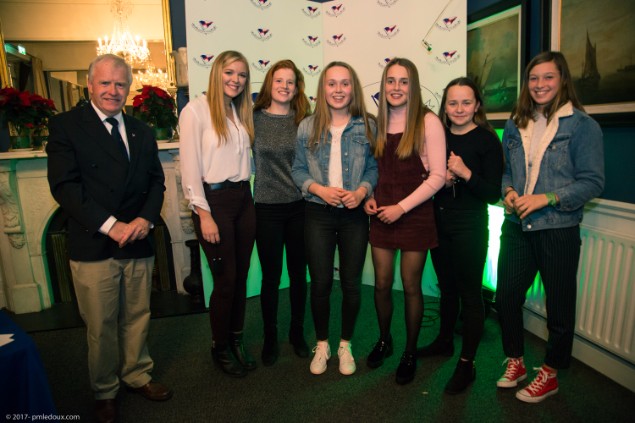
Junior Sailor Prizegiving at Royal Cork Yacht Club
The Junior Laying Up Supper celebrated a fantastic year afloat for Royal Cork youth sailing on Saturday.
Afloat.ie's photo gallery is below.

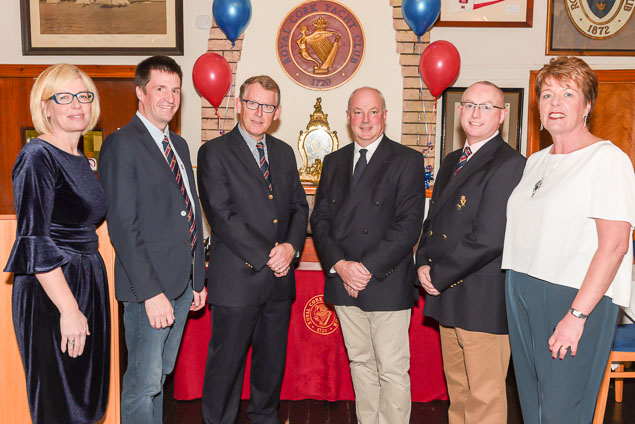
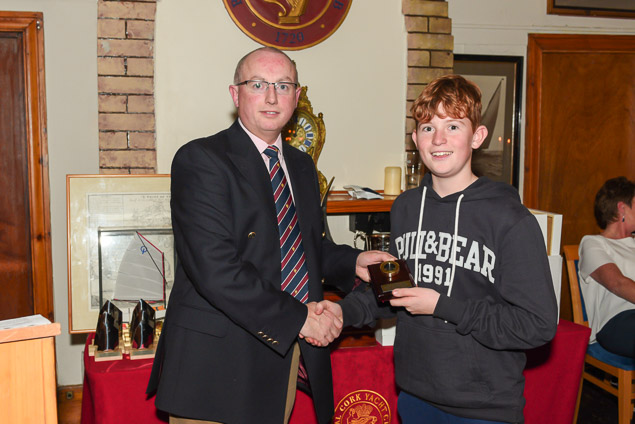
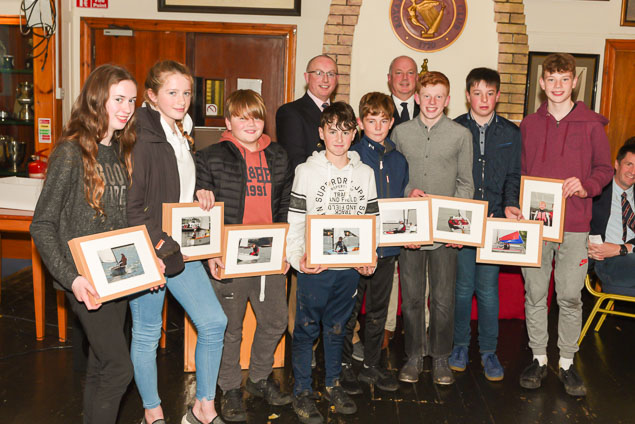
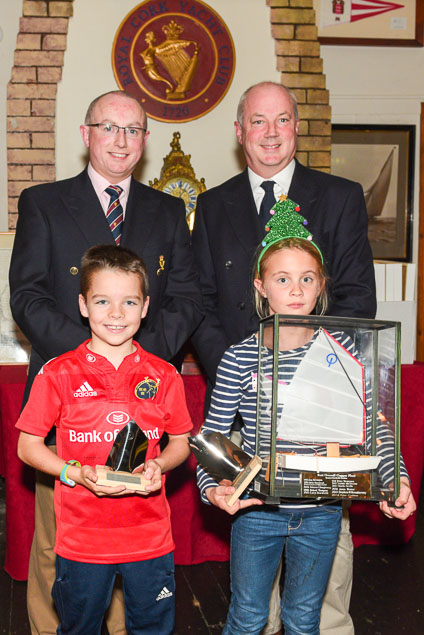
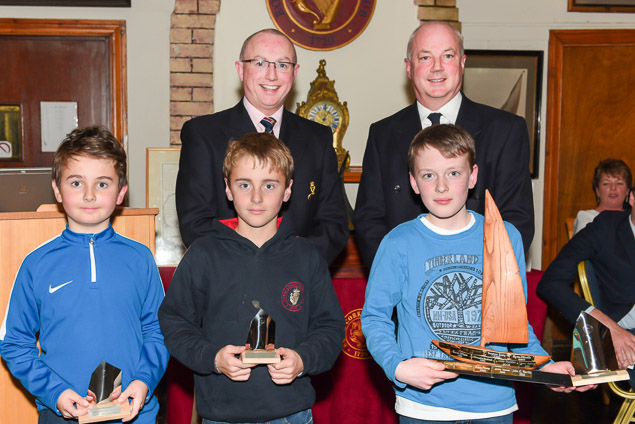

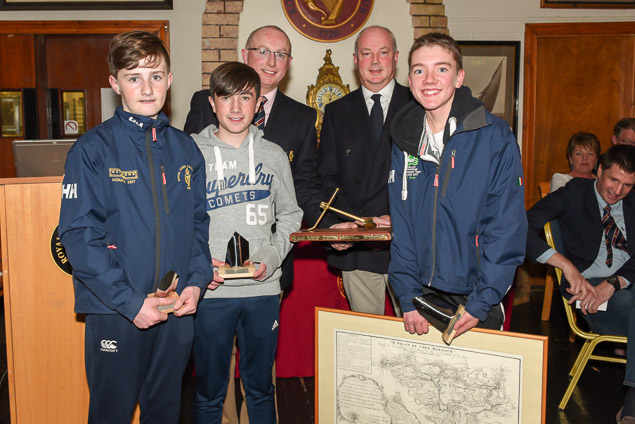
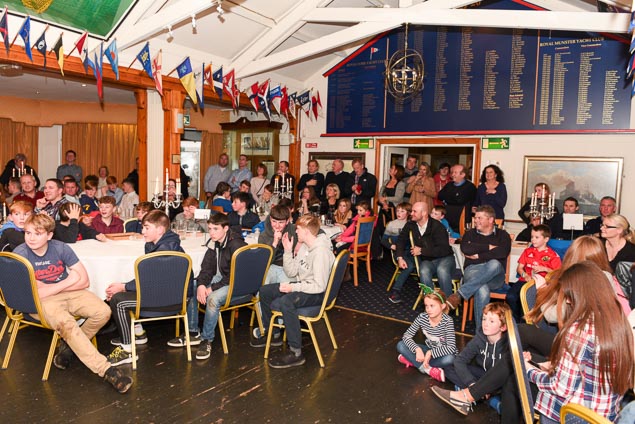
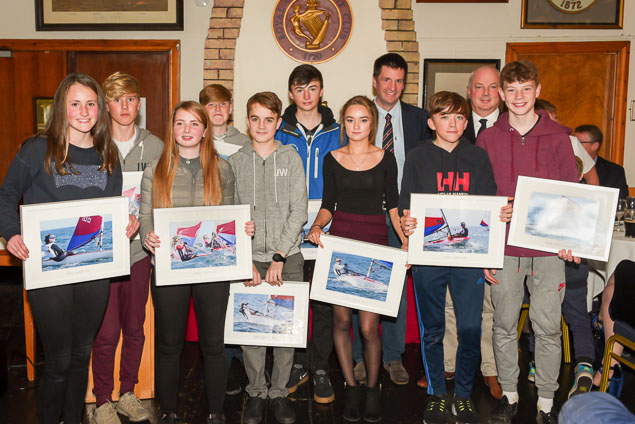
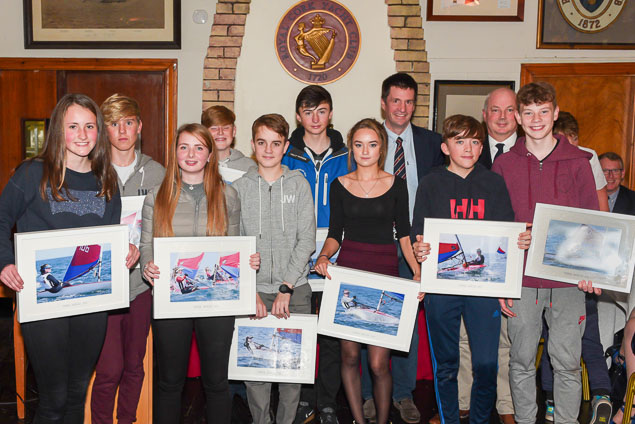
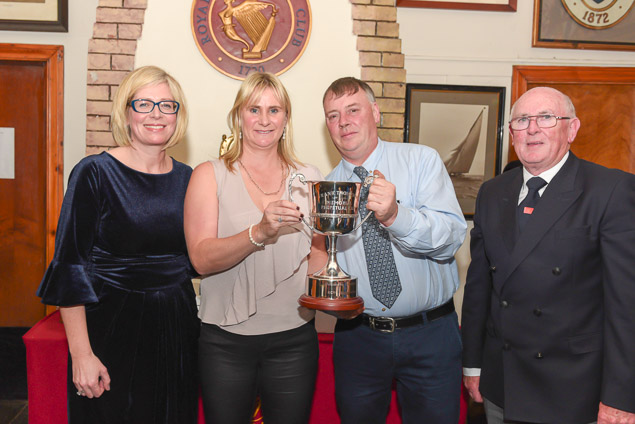
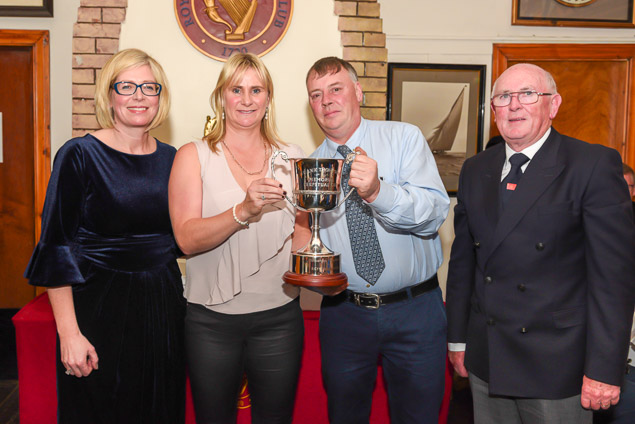

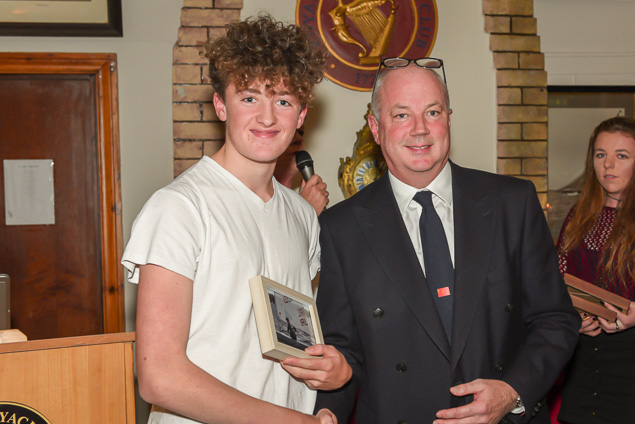
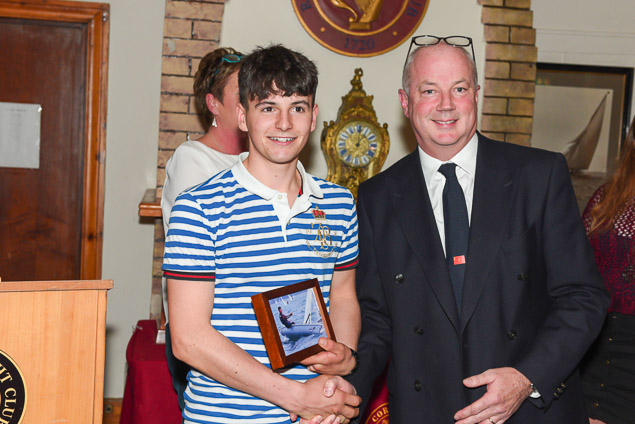
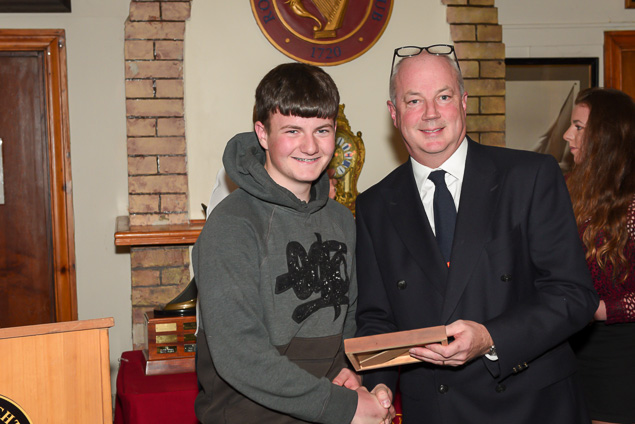
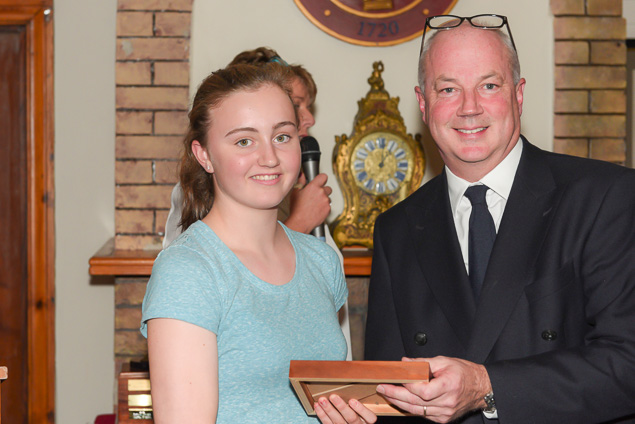

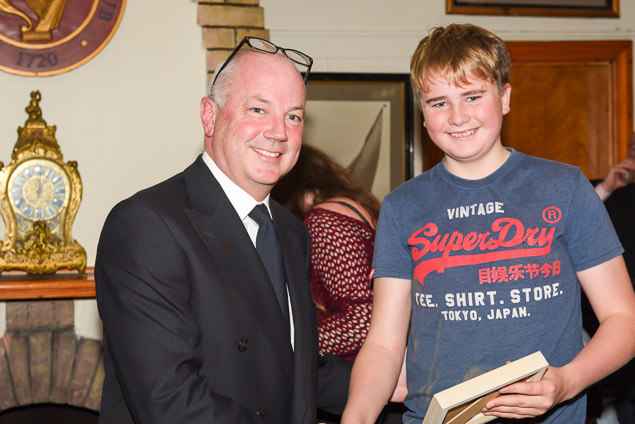
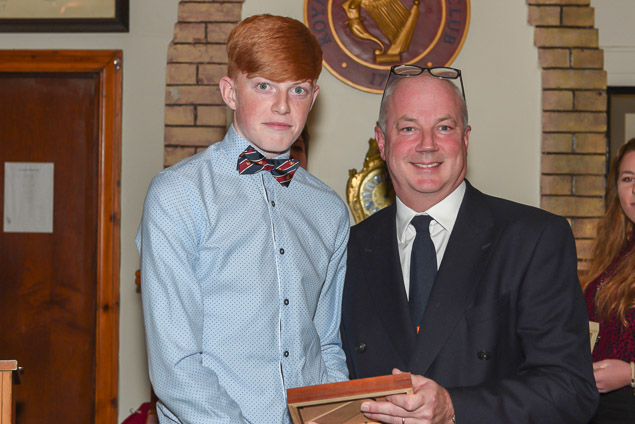
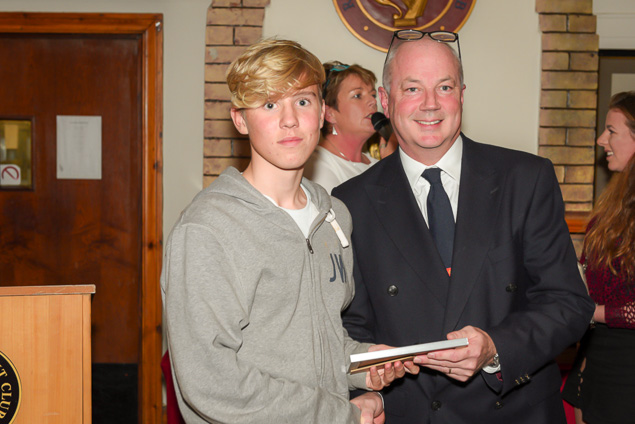


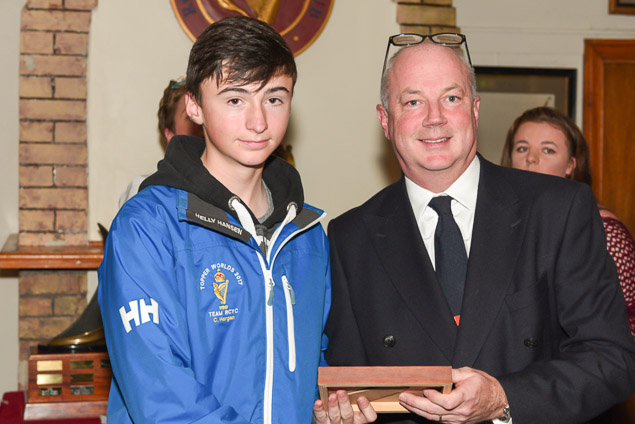
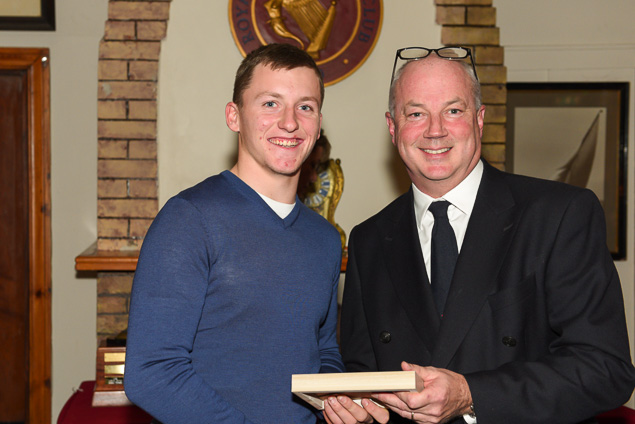



The Open 420 Training weekend hosted by the National Yacht Club over the weekend provided the sailors with the maximum range of sailing conditions possible for 420 sailing, from 3-30 knots. Saturday started with winds of 15–knots and gusts up to 30–knots with the wind speeds gradually reducing to close to zero by Monday afternoon.
This was the first Open Training session heading into the winter months and 22 boats registered from 13 separate clubs, Ballyhome in the north, Spiddal and Galway Bay in the west, Royal Cork in the south, Lough Ree and Mullingar in the midlands, and Malahide, Howth, Wexford Harbour, Greystones, Clontarf, The National Yacht Club and the Royal St. George on the east coast.
The training was led by Graham Grant and he was supported by a number of ex 420 Youth Academy sailors with European and World Championships experience, Adam Hyland, Cara Mc Dowell, Dougie Elmes and Sean Waddilove.
Although two of the 420 Academy boats were away in France for a regatta in La Rochelle the open training provided an opportunity for the many new 420 crews to experience training in a larger group and to meet some of the more experienced 420 crews in Ireland.
It's lining up to be an exciting week for youth sailing in Dun Laoghaire. The 2017 RS Feva Nationals take place over 3 days from 14 to 16 July at the Royal St. George Yacht Club.
As a warm up to the event there is a training session being held at the Royal St. George Yacht Club on Tuesday evening (July 11th) from 5:30 to 9:30.
In addition, the RIYC regatta is taking place on Wednesday (July 12th), providing another day of fun junior racing for the Fevas and other fleets.
With an asymmetric kite, the Feva is the most exciting dinghy available to children aged 11+ and provides a welcome alternative to the mainly single handed world of junior sailing. Fast, sociable, fun and requiring technical know-how, the Feva definitely ticks a lot of boxes. The World Championships are being held in Holland later this month with four Irish boats taking part in a 175+ boat fleet.
Starting next Friday (July 14th) there will be over 60 enthusiastic Feva sailors from more than 10 different clubs, enjoying close racing with 10 races spread over the 3 days.
There will be a Feva coach on hand for advise throughout the regatta, to help with last minute rigging issues and to make sure the sailors are having a good time with various on and off the water games planned. With Gold and Silver fleets and lots of prizes, all levels of ability are encouraged to come and take part.
Details including the Notice of Race and Online Entry are available here
142 boats across the 3 fleets are confirmed for this weekend's Munster Optimist Championships at Kinsale Yacht Club this weekend.
Six races are scheduled over the two days. The Senior and Junior fleets will race outside the harbour, weather permitting, with Principal Race Officer John Stallard at the helm while the Regatta Fleet will race in the outer harbour with Race Officer Siobhan Keane Hopcraft in charge of them.
As with all junior sailing events an enormous amount of support is required both on and off the water. A flotilla of Committee Boats, Mother Ships and support RIB’s plus the Dinghy Park will be manned by the many volunteers who are helping to make the event happen.
Kinsale Yacht Club has a very strong and active Optimist Class. The ever popular Christmas Regatta in December attracted an entry of 35 boats from a wide variety of clubs.
Mayor Encourages Young Sailors as Ballyholme Yacht Club Launch New SailQube Dinghy Fleet
Mayor Alderman Deborah Girvan of Ards and North Down Borough Council attended the first night of 'Dolphin & Sharks' at Ballyholme Yacht Club on Belfast Lough last Friday night writes Mark Mackey. The visit is to encourage the next generation of young sailors. Over 50 children aged from six–years–old enjoyed an evening of swimming with their friends off the slipways and playing with body surf boards.
The Mayor was down to see the launch of the new training fleet of six SailQube dinghies, the purchase of which has been supported by the Borough Council. The SailQube is a polyethylene–built Optimist dinghy – the very popular youth dinghy aimed at younger sailors, and will be used to encourage the smaller "Dolphin" sailors to sail by themselves. The Mayor also had a try in the new Training rib also supported by the Council which will help grow the numbers able to be looked after.
Ballyholme offer adult and youth courses throughout the summer – next Saturday is the annual RYA Push the Boat Out Free Trysail event running all day from 9:30. Everyone is very welcome to come down and try sailing for the first time on a variety of different boats depending on what you may fancy – singlehanded or double handed dinghies, catamarans, keelboats. You just need to enrol online at ballyholme.com.
Ireland Will Be Represented by UCD in Student Sailing Worlds
University College Dublin, led by Will Byrne, won through in an increasingly challenging national selection trials at Howth YC yesterday to take the honour of representing Ireland in the 37th Annual Student Yachting Worlds, which this year will be staged in the Mediterranean in the Autumn at Marseilles, and raced in J/80s.
Howth’s ready-to-go flotilla of club-owned J/80s thereby provided double value, and they provided much whoop-inducing sailing as the south’easterly built steadily during the day. This deteriorating weather was to mean that the usual club Saturday afternoon racing at both Howth and Dun Laoghaire was cancelled. But by that stage, thanks to a tight programme set in train by Race Officer Scorie Walls with the briefing in HYC at 0830 and the first gun at 1000hrs, the Intervarsity programme was already well on its way.
Although today (Sunday) had been pencilled in as a fallback day, the mood of the fleet was very strongly in favour of having it all done and dusted by the time the forecast even stronger winds were expected to arrive late on Saturday afternoon, and Scorie and her team were able to oblige.
By using Howth’s clear water race area between the protecting island of Ireland’s Eye and Portmarnock, the racing could continue as the wind shunted upwards towards the 27 knots-plus level, prompting the Race Team to quip that if Ireland’s Eye didn’t exist, then they’d have had to invent it.
Nevertheless even this shelter could only do so much in the very dense and increasingly fast moving air, and with some damage being sustained, the final had to be based on two races sailed between Cork IT Sailing, Trinity CD Sailing, NUI Galway, and UCD.
UCD were on a roll as they’d notched three wins and a second in the four qualifying races, and they maintained this pace into the two final contests, with Trinity as runners-up and NUI Galway placing third overall. Now Marseilles calls, and UCD have an entire summer for further training in J/80s racing. But meanwhile, extraneous matters like exams have to be dealt with....
ISA Youth Sailing Video from Ballyholme YC Here
Ballyholme Yacht Club has released a video of all the weekend action from Bangor Bay, the largest entry ever for the ISA youth national championships.
Read our full report here and see the latest video moments below:
One of the most notable aspects of the ISA Youth Pathway National Championship 2017, which has concluded this afternoon at Ballyholme on Belfast Lough with a good programme sailed, is the healthy way in which the new champions come from a wide range of clubs and sailing locations writes W M Nixon.
Admittedly, as the rising stars become more established as front runners, we find that bigger clubs at the main centres will make every effort to recruit this fresh talent onto their strength. Nevertheless with crews from as far away as Crookhaven Harbour, Dingle and Tralee Bay making their way up the long road to Ballyholme (and if you’re coming from Dingle, it is one very long road), there’s no escaping the feeling that the Annalise Effect is working. Irish junior sailing is not just undergoing a renaissance. It is putting out energetic new shoots in places where it was relatively dormant before, and the future looks rosy.
Prospects for today’s last races weren’t looking too good on some forecasts, with the lack of wind that bedevilled some of Saturday’s racing looking like persisting. But bang on cue a nice southwest to west breeze settled in on most of the sailing areas, and the fleets went at it as if they’d had no sailing at all until then, with the Optimist class particularly requesting that if at all possible they’d like three races.
 "The bringer of sunshine”. After a championship of mostly grey weather, the sun came out when ISA star coach Rory Fitzpatrick took ISA President Jack Roy out for a spin around the three course areas.
"The bringer of sunshine”. After a championship of mostly grey weather, the sun came out when ISA star coach Rory Fitzpatrick took ISA President Jack Roy out for a spin around the three course areas.
That was a tall order with the last starting sequence required to be no later than 1300hrs. But with very efficient turn-rounds after each race, the thing was done and the series was completed with that wonderful feeling of a good regatta accomplished, which is a whole world away from the default position of “Well, we got a result....”
As for the final results, in the end there were no surprises from the overnight positions. But while some leaders may now look to have been securely in place for some time, in most classes they had to keep working at it until the very end.
In terms of sheer scale of win, the star of the show has to be Justin Lucas (13), who gives his clubs as both Royal Cork and Tralee Bay, so you can guess his career trajectory. In a fleet of 62, after thirteen races he was discarding a 12th and an 11th, leaving a scoreline of 1,1,4,5,1,2,3,5,1,1,4 and a total only 28 points against the 72 of next-in-line Conor Gorman of the National YC.
Third place kept up the pace for remote clubs, as it was won by Harry Twomey of Crookhaven Harbur, then the next two slots were filled by the leading 12-year-old juniors, Johnny Flynn and Luke Turvey, who are both members of Howth, but they also give allegiance to Royal St George and National respectively.
Top girl sailor was Emily Riordan of Royal St George, she was 8th overall on 98 points, second girl was clubmate Alana Coakley at 11th while the National’s Leah Rickard was third at 12th overall.
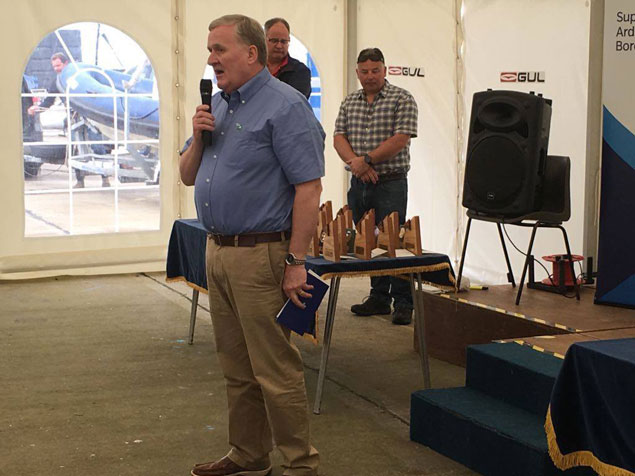 ISA President Jack Roy speaking at the awards ceremony at Ballyholme after the biggest ISA Youth Pathway Championship ever staged, with 208 registered sailors all under the age of 19 (and many very much younger) taking part.
ISA President Jack Roy speaking at the awards ceremony at Ballyholme after the biggest ISA Youth Pathway Championship ever staged, with 208 registered sailors all under the age of 19 (and many very much younger) taking part.
The little ’uns in the Optimists may have served up the numbers and an overall winner with a stratospheric lead, but inevitably the glamour class was the Laser Radials which had gone into Saturday night with Silver Medallist Ewan McMahon’s lead somehow looking vulnerable as he closed with an 11th while Cork’s Johnny Durcan, after a winter spent Laser racing in Australia, was coming on by leaps and bounds.
However, any evidence of super-kangaroo abilities were in short supply for the Durcan camp today, for although McMahon still looked off the pace with a 14th in the first race, Durcan was DNF, and when that was added to a BFD in Saturdays first race, his challenge was effectively over, and in the end he was 9th overall.
So McMahon’s 9th in the final race was enough to retain his lead with a final points total of 41. But all the excitement in the Laser Radials was elsewhere, as the talk today has been of the huge rush of Rush. Aaron Rogers of Rush Sailing Club was in fact the initial overall leader, but today it was clubmate Conor Quinn (who also lists Carlingford Lough YC as his affiliation) who set the pace, with an 8th and then a first to move into second overall, while Rogers took third overall by round the series with a 7th and a 13th.
For quite a few years, the population of Fingal aka North County Dublin was the fastest growing in Ireland, so it was only a matter of time before the new demographic began to show in the national junior sailing results. However, the smart money might have been on Skerries Sailing Club to lead the way, and for a while they did so. But now Rush Sailing Club is showing itself the pace-setter inshore at junior level as seen at Ballyholme, and offshore with the Kelly family in their all-conquering J/109 Storm.
But if you looked solely at club affiliation as an indicator of what’s going on where, the 33-strong Laser 4.7 fleet at Ballyholme would only have lead to confusion, as 2017’s overall winner Jack Fahy lists his clubs as Royal St George, Royal Cork, and Lough Derg. Presumably he has club subscriptions at the top of his preferred Christmas gift list.......
Be that as it may, his scoreline of 6,1,2,1,2,5 discarding his final 8th provides something for everyone. That said, Caoimhe Foster of Royal Cork came on very well at the end, starting with a discarded 11th but recording three straight wins on the trot in the final trio of races, to share 22 points with Clare Gorman of the National with Fahy five points ahead of them at 17, Foster edging ahead into second on the countback to make her first girl.
It came within an ace of being first girls every which way in the 420s, as Malahide’s Gemma McDowell and Emma Gallagher took second in the first race astern of Nicola and Fiona Ferguson of the national, but with overnight leaders Geoff Power and James McCann of Dunmore East losing places back in fourth. The final race might have changed things overall, but Power & McCann did the business by being fourth with McDowell and Gallagher in fifth. So Dunmore East had it over Malahide by two points in the end at 18 to 20, while Royal St George’s Kate Lyttle and Niamh Henry were third on 21.
The competition is clearly close in the 420s, but in the Topper fleet of 32, much had been expected beforehand of northern star Jenna McCarlile of County Antrim Yacht Club at Whitehead, which is straight across the lough from Ballyholme.
But Jenna had a sporting quandary, as the first day’s racing clashed with her trial for the Ulster Under-16 Hockey Squad. She went for the hockey, and qualified. And then she threw herself into the sailing at Ballyholme. But even with three firsts, a 3rd and a 7th, the fact that the Toppers only had enough races for one discard made the mathematics impossible.
Nevertheless a sixth overall when short of a whole day’s racing is quite some achievement. But Heaven only knows what they’ll make of it all at Irish Topper HQ, as we read somewhere that only the first five places in the fleet at the Youth Nationals were eligible for positions in the Pathway programme......
Meanwhile among those who did the complete fixture, Rob Keale of Royal Cork continued his excellent progress with a scoreline of 1,1,4,3,2,4 with a discarded 10th to put him at 15, four points clear of Dan McCaughey of Ballyholme and Donaghadee, with Conor Horgan of Royal Cork third on 20 and Sarah Jennings of East Down fourth and also first girl. As for the Topper 4.2s, Lewis Thompson of Donagadee maintained his overnight dominance, in fact at the end he was discarding a second, but Adam Irvin of Irish National Sailing School in Dun Laoghaire came through on this final day to move into second overall with two seconds, while Hannah Dadley-Young of Ballyholme was third overall with two fourths today.
 This is the sort of crowd that soon overfills the marquee after the Youth Championship which beats all others. Meanwhile, all parents absent from this pic are loading up the boats for the long haul home…
This is the sort of crowd that soon overfills the marquee after the Youth Championship which beats all others. Meanwhile, all parents absent from this pic are loading up the boats for the long haul home…
Even as we post this on Afloat.ie, there are some little people with their tiny boats and long-suffering parents who still have a very long way to get home to many distant corners of Ireland after this cracker of a regatta. We wish them a safe journey. And for many of them, it’s back to school tomorrow after the Easter holidays. Gosh, what fun....
Full results are here. Optimist trials results may be found here.
Ballyholme YC adds:
Ewan McMahon won the ISA Youth Pathways despite another difficult day in a light shifting south westerly on Belfast Lough. His earlier form in the championships allowed him to discard the higher of his two results today and comfortably win overall. The two Rush sailors Conor Quinn and Aaron Rodgers had better results with a win in the last race for Conor to lift him to second overall from Aaron by one point. Royal North of Ireland's Sally Bell won 1st lady.
Geoff Power and James McCann wrapped up the 420 fleet even with the worst scores of the top four. The best results went to the Ferguson sisters - Nicola and Fiona - with two 1sts although not enough to break into the tight top three places. Only 3 net points over 9 races split the winners from Gemma McDowell in second place overall and 1st lady crew, and Kate Lyttle and Niamh Henry in third.
In the Laser 4.7 fleet on Course 2, Caoimhe Foster won both races on the final day to lift her to second overall and first lady. Jack Fahy had seen victory stolen from him before last summer at the Topper Worlds when he had been outgunned on the final windy day by the English squad sailors. This time his lead was large enough to maintain first place overall while Clare Gorman was third.
In the Topper fleet Rob Keal scored consistently to wrap up the championship. Local sailor from Ballyholme and Donaghadee - Dan McCaughey - won the final race to jump up to second overall while Conor Horgan was third. Sarah Jennings was first lady.
Another Ballyholme/Donaghadee sailor Lewis Thompson won the final two races and was the overall winner in the Topper 4.2 fleet with a net score of just 6 points from 7 races. Adam Irvin rose above Hannah Dadley Young for second place with Hannah first lady and third overall
The Optimist fleet on Course 3 managed to complete three races today with Race Officer Harry Gallagher determined to complete the full schedule. Justin Lucas continued his grip on the fleet with another 2 wins to add to his 3 earlier in the championship. Not only did he win overall but his net points were almost 50 points better than Conor Gorman in second and Harry Twomey in third. Emily Riordan was first girl.
ISA President Jack Roy thanked Ballyholme Yacht Club for successfully hosting the championships for the first time with the strong hint that it would return to the North again in future years.
Ballyholme Commodore Mark Mackey thanked all of the competitors and their families for travelling up to Bangor and making the event such a success - the largest entry ever. Thanks were also given to the Mayor Deborah Girvan and Ards & North Down Borough Council and Quay Marinas who supported the event, and CH Marine and McCready Sailboats who helped sponsor the prizes.
Thanks were also given by Jack and Mark to all of the Race Management team - the Principal Race Officer Robin Gray supported by Angela Gilmour, Harry Gallagher and Ruan O'Tiarnaigh, the Jury under Chris Lindsay and Gordon Davies, the 100 plus volunteers on the water and ashore helping at the event along with Eurosaf visitors and Andy Millington from the RYA marklaying team, and finally the event organiser Richard Glynn - more famous as the travelling father and sponsor of previous Topper World Champion Liam Glynn who is now campaigning in the Laser and just back from training in Croatia. Special thanks also went to the volunteers from local clubs in Belfast Lough and across Northern Ireland who took time off work this week and without who's help it would have been impossible to run three courses so successfully.
After the Prize Giving the teams for the various Irish Optimist squads travelling to the World Championships, Europeans, the ICT Poland and ICT France squads were read out - with particular special significance for Leah Rickard from the National Yacht Club who was born in Thailand and has qualified to travel to the World Championships which will be held there later this summer.
Lighter breezes at Ballyholme have been providing some very different sailing conditions for today’s third day of racing in the ISA Youth Nationals on Belfast Lough. But in all classes the overnight leaders have stayed in front, with an exceptional pace being set by Justin Lucas of Tralee in the Optimists. He has been able to discard an 11th and 12th in a fleet of 62 boats, to have him on 22pts to the current next in line, 12 year old Luke Turvey of Howth and National who was 7th and 3rd in the most recent contests, nevertheless he’s back at 50pts.
The battle of the titans in the Laser Radials was frustrated by lack of wind in their race area, they only completed one race but it saw points leader Ewan MacMahon back in 11th while his closest challenger Johnny Durcan took a useful 4th and Aaron Rogers of Rush got back in the game with a third. Current scoreline is McMahon 21, Durcan 28 and Rogers 31.
Full results are here. Optimist trials results may be found here.
After the strong breezes of yesterday, many of the 200 plus sailors plus the race management team were glad to see flatter seas this morning with a light and cold 6 knot breeze.
 Topper sailors make the most of the light winds on Belfast Lough. Photo: Simon McIlwaine
Topper sailors make the most of the light winds on Belfast Lough. Photo: Simon McIlwaine
Unfortunately for Course Areas 1 and 2 for the ISA Youth Pathway fleets, the breeze soon died away a little and all classes only managed one race despite many attempts across the day. With lighter winds, the tide cam into play for some of the fleets making it difficult to stay behind the line and most classes struggled with General Recalls, Uniform and Black flag starts.
Course 3 is set a little closer to Ballyholme Bay and further out into the lough than the other fleets and got the best of the conditions today with the Optimists managing 3 races - the last of which dragged on with a long final race. Sadly the breeze then filled in but the young sailors were by then tired and cold and sent home with Race 4 of the day postponed until tomorrow.
Harry Twomey made the most of the difficult conditions with two 1sts in the first and last race of the day. Johnny Flynn won the middle race with a great downwind leg which was finished at the bottom gate. The most consistent sailor however has been Justin Lucas fully deserving his overall lead at the end of Day 3 with three top 5 results and now counts only 22 points after 10 races with discards.
On Course 1, Gemma McDowell and Emma Gallagher got the best start of the 420 fleet whilst Geoff Power and James McCann struggled to keep speed and had to tack off after getting leebowed. The girls 1st place squeezes up the points margin between themselves and the boys who continue to lie 1st overall.
In the single race for the Laser fleet County Antrim's (Whitehead) Andrew Mitchell had his best race of the series with a bullet. Johnny Durcan saw the greater breeze on the left hand side of the course being enjoyed by the 420 fleet and managed a 4th whilst Ewan McMahon now discards the 11th he scored when struggling on the right hand side.
On Course 2, Caoimhe Foster had a great race in the Laser 4.7 with a win from Jack Fahy who continues to lead overall. Newcastle's Erin McIlwaine (also the daughter of our photographer) had a great day with a win in the Toppers and moves up to 3rd place on equal points with joint Donaghedee/Ballyholme's Dan McGaughey. Rob Keal continues to lie first overall with Conor Horgan in second. Adam Irvin from the Irish National Sailing School in Dun Laoghaire won his first race in the Topper 4.2's with Lewis and Hannah leading still overall.
Three races are now scheduled for all classes tomorrow on the final day of racing in an attempt to catch up from those races postponed.


























